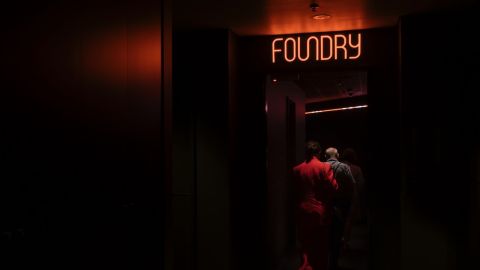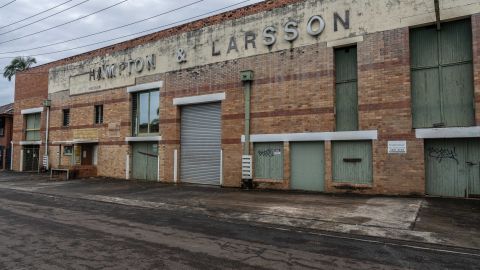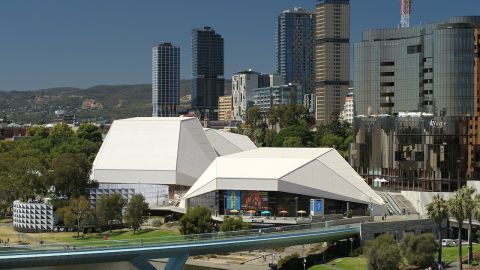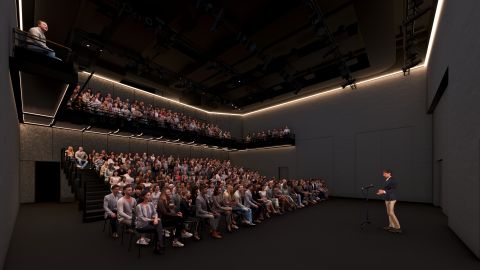Axe Falls on Much Loved Theatre Program
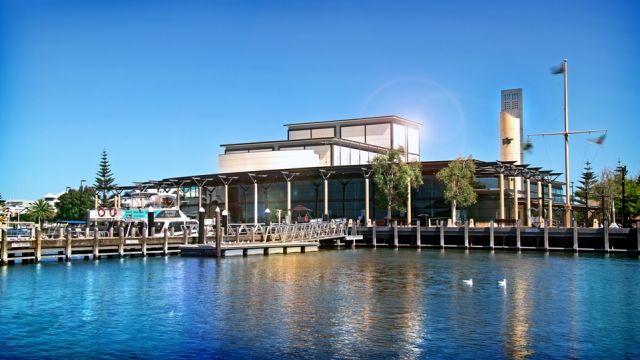
Should Regional Theatres just be ‘halls for hire?’ The common model is renting to locals and buying in professional productions from the big smoke. Some choose to put the Producer’s hat on and stage shows themselves. The decision of a major Performing Arts Centre to axe a much-loved in-house production program has brought the issue to a head. *David Spicer looks behind the curtain across Australia and New Zealand.
One hour south of Perth, the Mandurah Performing Arts Centre glistens in the sunlight of the Murray River. Completed in 1997 for $18 million, it has a superb position near a ferry terminal and includes a first class 800-seat theatre and art gallery.
In a moat feature, which forms part of the centre’s courtyard, there is an intriguing sculpture of a famous local tragedy, depicting a group of nuns sitting in a boat. When I visited the centre, the manager Lesley Couzens explained to me that early in the 20th Century a group of nuns went on a trip into the local estuary, but drowned in treacherous conditions.
 Lesley Couzens, who died in 2008, was a great champion of the local community and the centre’s unique program of in-house theatre productions.
Lesley Couzens, who died in 2008, was a great champion of the local community and the centre’s unique program of in-house theatre productions.
Now her husband Les is leading a campaign against what he considers to be another local calamity.
Unlike most regional theatres, the venue itself staged up to five productions of community musicals, plays and children’s theatre each year, clocking up more than 50 since 1997.
Les Couzens says, “because of the tyranny of distance the venue had to provide its own program. The aim was also to lift the bar, and stage a higher standard of production than provided by local amateur theatres. It forced the others to lift their game.”
He says there have been many memorable productions including the WA premiere of Beauty and Beast.
 An army of volunteers assisted.
An army of volunteers assisted.
“They made costumes, worked backstage, were ushers and ran parades to promote the enterprise on a grand scale,” he said.
In November, the cast rehearsing for the latest show received a bombshell. The Board announced that the program would be axed.
Chairwoman Emeritus Professor Joanna Professor Barker said, “The rationale is that community members on a survey have stated they wish to see an increase in the number of international and national shows. The last two in-house musicals were a large financial loss with small audience number; and importantly during long periods of rehearsals the Centre can’t be utilised for other shows.”
 Les Couzens disputes this.
Les Couzens disputes this.
“How can they have made a loss when they had full or almost full houses? The Board which runs the venue is very short on qualifications in the entertainment industry and has made the wrong decision,” he said.
As with any town, there is also a bit of local theatre politics.
The centre’s General Manager Guy Boyce has indicated that the Council run venue sometimes put noses out of joint.
“In-house programs have become focussed on presenting a limited number of musical theatre seasons, precluding the centre from supporting concert bands, opera and circus. At the same time, other organisations are also presenting musicals that directly compete with the centre for cast, crew and audience,” he said.
Looking around Australia, it is unusual for theatres to produce their own community theatre productions.
The biggest of their kind took place for many years at The Gold Coast Arts Centre. With budgets sometimes topping $250,000, it was a piece of Broadway on the Gold Coast, with glitz, lots of feathers and big production values. This program was axed a few years ago by new management.
“Some of the community was in uproar,” says the current program manager Brad Rush. “Previously The Arts Centre was like the amateur scene and regularly did three shows, but it overtook resources and pushed out a more diverse program. Now we have space for a season that includes Bell Shakespeare, Bangara Dance Theatre, Circus Oz and great children’s theatre.”
The Gold Coast is not abandoning community productions entirely. Its well-respected summer school for 15 to 21 year olds continues. In January it staged Beauty and the Beast.
The Centre is also presenting the world premiere of a new Australian musical, a jukebox musical set on the Gold Coast called Pyjamas in Paradise, by Peter Pinne and John Michael-Howson.
“There is a reason for doing this musical, as it reflects on local history and is a World Premiere,” he said. “We also now have a new space – a black box theatre for 100 people - which is being used for independent theatre, dance and drama. So we are developing our local artists.”
Another major reason why the Gold Coast Arts Centre thought it was reasonable to downsize its in-house theatre program is that the city is crowded with amateur companies.
Also it is clear that the Gold Coast Arts Centre is now better funded to develop local artists.
 In other parts of Australia, some managers are still enthusiastic about staging community productions. One of the biggest reasons is that they can absolutely blitz other productions at the box office.
In other parts of Australia, some managers are still enthusiastic about staging community productions. One of the biggest reasons is that they can absolutely blitz other productions at the box office.
Late last year the Wagga Wagga Civic theatre staged The Boy From Oz and sold every ticket during a 13-performance season in their 500 seat venue. It was musical of the year at the local annual C.A.T. Awards.
“Producing work that involves the Wagga community is a focus for the theatre, to give performance opportunities for the talented performers of Wagga. It allows people to extend themselves, developing their skills further in a professional environment,” said Manager Anne-Marie Heath. “Local work always has strong ticket sales, but like any production it depends on the quality and how it is marketed.””
Another successful model is the Empire Theatre in Toowoomba, which has been staging plays and musicals now for a decade. I attended a superb production of Singin’ In the Rain, run by the theatre and directed by its full-time Theatre Director Lewis Jones. This year the venue is producing The Boy From Oz and Secret Bridesmaids Business. They call them pro-am.
“We pay the creative team, using local talent if available, but have contracted directors, designers, musical directors and choreographers from around Australia,” said General Manager Anne-Marie Ryan.
“The cast is usually volunteer, but we will pay principals if we cannot source talent locally as is the case with Boy from Oz this year,” she said.
These productions also offer professional development opportunities for assistants under the mentorship of the creative team. They are hugely popular, attracting a broad cross-section of the community, with the addition of workshops to train the inexperienced in the weeks leading up to auditions.
“Our musical productions usually sell more tickets than any other product,” she said.
Some regional theatre venues, which began life as a hub for community theatre, become targets for accusations that they have become elitist.
Patrick Corrigan, who set up the in-house production program at Mandurah, says, “Australia is littered with these places that start out as cultural icons with the aim to develop performing arts locally, but very soon they are reduced to halls for hire.”
“Imagine spending 30 or 40 million dollars on a library and not putting books in it. People would laugh you out of the state. The idea to make it an elitist room is short sighted,” he said.
“Musicals don’t tour, so they have to be produced locally, and the best way is to have some input from the local venue. If you look at what people like to look at and see, musicals are the highest earning and they are a huge outlet for singers and musicians.”
It is not always the fault of regional theatre managers. In some cases local amateur theatre companies become very comfortable in their regular theatres, which they often own, and refuse to consider transferring into their town’s big theatre.
On the other hand, these amateur theatre companies sometimes complain of the high cost of staging their productions in their town’s biggest venue.
Near Sydney, different traditions have emerged. On the Central Coast the Gosford Musical Society has developed a long tradition of high production standard musicals in region’s premiere venue, the Laycock Street Theatre. The two institutions are literally attached, with the GMS rehearsal shed joined to the theatre.
South of Sydney, in Wollongong, the Illawarra Performing Arts Centre (IPAC) only rarely has full-scale community theatre productions. The IPAC is almost entirely dominated by elite artists or the occasional dance school. The biggest local club, the Wollongong Arcadians, stage all their shows in their own venue.
Recently I licensed a production of Hot Shoe Shuffle by an independent producer at IPAC and heard that the venue’s management were ‘surprised’ to find that the musical was their best seller of the year. If you looked at the venue, all the promotion inside and outside was directed at promoting the theatre’s bought in season of professional productions.
The situation in New Zealand is different. While it has a multitude of outstanding venues, the producing skill base of theatre managers appears to be limited.
An industry insider told Stage Whispers that “Entertainment Venues are mainly Council owned, and more often than not have managers that know very little about the performing arts."
"Venues, at this point in time, rarely produce work, as they don't have a budget for this. Councils do not think of it as they have little understanding of theatre.”
An exception is the Hawkes Bay Opera House, "because the people running it actually know something about theatre and have worked hard to make something happen."
Program Manager Megan Peacock-Coyle recently brought a series of gritty plays by Samuel Beckett, Harold Pinter and Steven Berkoff to her community. These were short solo plays rather than large cast community productions.
The situation at Mandurah has taken a new twist. The theatre has seen the wisdom of fostering local talent but wants to do it a different way.
It recently called for submissions from local groups interested in “developing a range of co-productions” with the venue “seeking to add value to each production through venue, technical production, creative and marketing support.”
“The Centre is keen to receive details of a wide range of production genres including drama, circus, physical theatre, dance, choral and musical works. In particular, the Centre would welcome proposals for Family productions that would be presented in January of each year.”
So it looks likely that some form of community production will remain at the centre, but not at the same level as it was before.
The new brief includes scope to develop local stories and they are offering to read unpublished works.
Perhaps there might even be room one day for a production about a group of nuns going for a boat trip?
*David Spicer is the agent for The Boy From Oz, Hot Shoe Shuffle and Pyjamas in Paradise.
To keep up with the latest news and reviews, like us on Facebook, or follow us on Twitter.
Originally published in the March / April print edition of Stage Whispers.
Images - Top - Mandurah Performing Arts Centre and it's water feature.
Ben Gillespie as Don Lockwood in Singing in the Rain at Toowoomba's Empire Theatre

